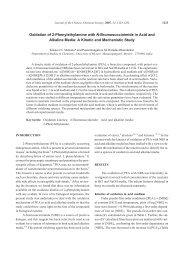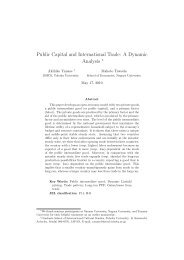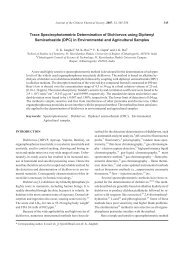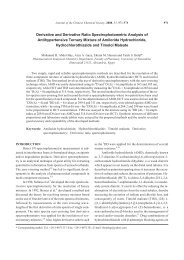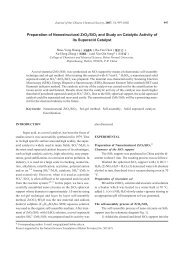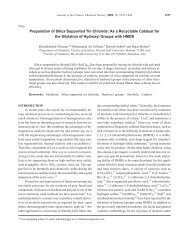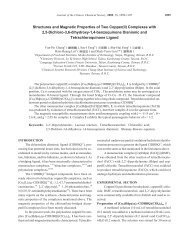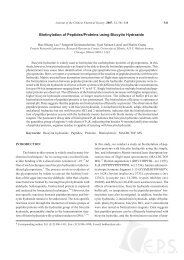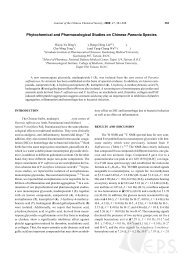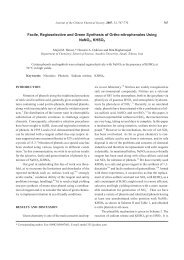Synthesis of Gold Nanosheets through Thermolysis of Mixtures of ...
Synthesis of Gold Nanosheets through Thermolysis of Mixtures of ...
Synthesis of Gold Nanosheets through Thermolysis of Mixtures of ...
You also want an ePaper? Increase the reach of your titles
YUMPU automatically turns print PDFs into web optimized ePapers that Google loves.
Fabrication <strong>of</strong> <strong>Gold</strong> <strong>Nanosheets</strong> <strong>through</strong> <strong>Thermolysis</strong> J. Chin. Chem. Soc., Vol. 56, No. 1, 2009 99<br />
anol (50 mL) were stirred for 2 h. The volume <strong>of</strong> the resultant<br />
solution was reduced to 5 mL by rotary evaporator. The<br />
precipitate was filtered and washed two times with ethanol<br />
(5 mL), the solid was collected and dried under vacuum.<br />
The yield was 65%. 1 H NMR (ppm, d 6 -DMSO): 0.83 (t,<br />
3 J = 7 Hz, 3H, CH 3 ), 1.19-1.35 (m, 30H, CH 2 ), 1.77 (m,<br />
2H, CH 2 ), 4.15 (t, 3 J = 7 Hz, 2H, CH 2 ), 7.67 (m, 1H, CH),<br />
7.75 (m, 1H, CH), 9.11 (s, 1H, CH). Anal. Calcd. for<br />
C 21 H 41 N 2 AuCl 4 : C, 38.20; H, 6.26; N, 4.24. Found: C,<br />
38.65; H, 6.44; N, 4.38%.<br />
Preparation <strong>of</strong> (C 18 -im)AuCl 3·C 18 H 37 -im (200 mg,<br />
0.62 mmol) and [HAuCl 4 ] (220 mg, 0.65 mmol) in ethanol<br />
(50 mL) were stirred for 2 h. After which, the solvent was<br />
removed by rotary evaporator. The residue was dissolved<br />
in CH 2 Cl 2 (20 mL), to which silica gel (5 g) was added and<br />
stirred for 30 min. This was then filtered and the filtrate<br />
was collected and dried under vacuum to give the product<br />
with yield <strong>of</strong> 55%. 1 H NMR (ppm, d 6 -DMSO): 0.83 (t,<br />
3 J = 7 Hz, 3H, CH 3 ), 1.19-1.35 (m, 30H, CH 2 ), 1.95 (m,<br />
2H, CH 2 ), 4.15 (t, 3 J = 7 Hz, 2H, CH 2 ), 7.65 (m, 1H, CH),<br />
7.70 (m, 1H, CH), 9.08 (s, 1H, CH). Anal. Calcd. for<br />
C 21 H 40 N 2 AuCl 3 : C, 40.43; H, 6.46; N, 4.49. Found: C,<br />
40.75; H, 6.55; N, 4.35%.<br />
<strong>Synthesis</strong> <strong>of</strong> Au Crystals<br />
To prepare precursor <strong>of</strong> [C 18 -im]/[HAuCl 4 ] (4:1),<br />
C 18 -im (0.38 g, 1.2 10 -3 mmol) and HAuCl 4 (0.10 g, 3.0 <br />
10 -4 mmol) were mixed in ethanol (50 mL) and the mixture<br />
was stirred for 1 h. The solvent was then removed by rotary<br />
evaporator. The residue was collected and dried under vacuum.<br />
To form Au nanostructures, the resultant mixture was<br />
heated at 200 o C for 1 h in a sealed glass tube. These thermal<br />
treated solid products were collected and washed several<br />
times with ethanol. Similar procedures were applicable<br />
for other ratios and imidazoles. Samples with HAuCl 4 up to<br />
1.0 g worked equally well.<br />
Instrumentation<br />
X-ray diffraction analysis <strong>of</strong> the samples was carried<br />
out using an X-ray diffractometer (XRD D8 Advanced,<br />
Bruker and XRD Rigaku D/max-2500, Japan) with Cu K <br />
radiation. The morphology <strong>of</strong> the as-prepared products was<br />
characterized by scanning electron microscopy (SEM,<br />
JMF-6500F. JOEL) and transmission electron microscopy<br />
(TEM, JEOL JEM-3010, operating voltage <strong>of</strong> 300 kV). A<br />
ZEISS Axioplan2 imaging polarizing microscope equipped<br />
with a Mettler FP 82 hot stage and a Mettler FP 90 central<br />
processor was used to examine and follow the growth <strong>of</strong><br />
the nanomaterials. The 1 H NMR spectra were recorded on a<br />
Bruker AC-F300 spectrometer. Infrared (IR) spectra <strong>of</strong> the<br />
samples were measured on a Perkin-Elmer Fourier transform<br />
spectrophotometer (model spectrum one) with a LITA<br />
(lithium tantalite) midinfrared detector.<br />
RESULTS AND DISCUSSION<br />
<strong>Thermolysis</strong> <strong>of</strong> [C 18 -im]/[HAuCl 4 ] = 4:1 at 200 o Cfor<br />
1 h in a sealed glass tube produced mostly shining Au platelets<br />
in >85% yield. To monitor macroscopically the progress<br />
<strong>of</strong> thermolysis, an optical microscope equipped with a<br />
temperature-controlled hot stage was employed. Precursor<br />
<strong>of</strong> [C 18 -im]/[HAuCl 4 ] = 4/1 sandwiched between two slide<br />
glasses showed the melting began at 125 o C; upon continuedheatingto200<br />
o C, small particles are formed at an early<br />
stage; platelets are subsequently formed and grew (Fig. 1).<br />
Since nanoscale particles could not be observed via optical<br />
microscope, the growth <strong>of</strong> nanostructures was followed by<br />
TEM. For a reaction time <strong>of</strong> 1 min, spherical Au NPs in<br />
20-40 nm diameter were observed (Fig. 2a). Increasing the<br />
duration <strong>of</strong> thermolysis to 3 min, worm-like nanostructures<br />
<strong>of</strong> ca. 50~100 nm and nanoplates <strong>of</strong> 60-160 nm lateral<br />
lengths were formed (Fig. 2b1-2). Reaction quenched after<br />
30 min, produced platelets <strong>of</strong> ca. 500 nm lateral lengths<br />
along with small amount <strong>of</strong> irregular faceted particles <strong>of</strong> ca.<br />
100 nm (Fig. 2c). For a reaction duration <strong>of</strong> 60 min, SEM<br />
image revealed that predominantly hexagonal and triangular<br />
plates with lateral sizes <strong>of</strong> ca. 50 m and thickness <strong>of</strong> ca.<br />
100 nm, together with ca. 1 m irregular faceted particles<br />
are present (Fig. 2d). Although several processes have been<br />
known for the preparation <strong>of</strong> large Au nanoplates, our work<br />
presents an alternative simple method to fabricate Au nano-<br />
Fig. 1. Monitoring the thermolysis <strong>of</strong> a mixture <strong>of</strong><br />
[C 18 -im]/[HAuCl 4 ] (4:1) at 200 o Conaglass<br />
slide by POM for (a) 4 min, (b) 6 min, and (c) 8<br />
min.



